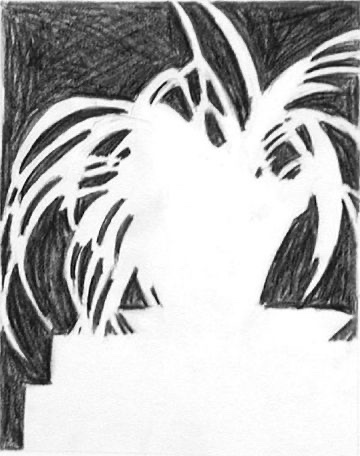
Learning Objectives
- Students will be able to accurately capture objects using contour drawings.
- Students will be able to differentiate between positive and negative space.
- Students will be able to create engaging compositions through the arrangement of shapes and lines.
- Students will demonstrate an understanding of correct color mixing, basic knowledge of color theory, and correct painting techniques.
Materials
- 2 sheets of 9″ by 12″ Bristol Board
- Set of Acrylic Paints (Need at least Red, Yellow, Blue and White)
- Small Acrylic Paint Brushes
- Copy Paper or other loose paper
- Pencil and pen
- Tracing Paper
Sketchbook
- In your sketchbook or on a piece of Bristol board, create 3, 7 step monochromatic color scales. Monochromatic means one color, so you will choose one color and gradually make it lighter until you reach white. Example
- Using the Adobe Color website, create at least 8 different color schemes. Choose 3 of these to recreate in paint on Bristol board. Label them according to which color scheme they belong too. Try to avoid analogous color schemes. Reference
- Must be done before coming to class – 10 Contour / Negative Space Drawings of architecture and / or plants. The examples below are Contour or Negative space drawings. You are combining this idea. You’re drawing the negative space as an outline but don’t need to fill it in.
- On a piece of Bristol board, draw a sphere and a box. Try to use a real ball or box as a model so that you can see what happens when light hits the object. Choose a different color for each and paint them so that they appear three dimensional. Examples are below.
Examples of Painting a Cube and Sphere


Examples of Contour / Negative Space Drawings:








Project
Overview:
Preparing the Compositions:
- For this assignment you will need to complete 10 contour / negative space drawings of architecture (power lines, gaps between buildings, stop light wires) or other linear objects (vines, plants, trees). These are simple line drawings so don’t spend more than 10 minutes or so on each of them. You can include the buildings themselves or if you’re doing power lines, the poles, stop lights, transformers, etc. You will need to create these contour drawings on standard 8.5 x 11 loose copy paper – not your sketchbook. Try to capture as many details as possible and remember that you are drawing the negative space, the air around the object, not the actual building or plant itself. Focus on the positive (the object itself) and the negative (the sky or air) to create your drawings. Try parking in a business parking lot that faces an intersection or visit a garden center. You can sit in your car, turn the music up, and get some really interesting drawings
- Once you have your 10 different drawings, start looking for interesting combinations by overlapping them. If you can’t see through the paper, you can tape your drawings to a window backlit by the sun to help. You might overlap a drawing of vines with a drawing of powerlines to create a nice contrast between organic and geometric shapes. You may use certain elements more than once if that works for your composition.
- Take a sheet of tracing paper and draw a 5″ by 8″ rectangle. Lay the sheet of tracing paper over the collection of drawings and move it around until the best part of your composition fits your rectangle. Slowly trace the lines onto the tracing paper. You don’t need to include everything – these drawings are meant to help you create a composition, not force you into one. Push your lines all the way to the edge of your 5″ by 8″ rectangle. Let me see these compositions before you go on to the next step.
- Use a 2B or higher (3B, 4B, 6B…) to completely cover the back of your tracing paper. Once you are done, lay a sheet of bristol board underneath, making sure that your rectangle is centered, and, using a ball point pen, slowly trace your lines. Be careful not to let the paper move and don’t push down to hard. Once you are done the tracing paper drawing should have transferred to the bristol board
Painting:
Once you have your 3 different compositions created, you will be painting them with acrylic paint. You will need to work out color compositions in your sketchbook before you start painting. Think analogous, complement, split complement, triadic, etc. Once you have your colors worked out you will paint your compositions with the utmost attention to detail. No white should be seen and the paint should be applied as evenly and as flat as possible. Start with your lightest colors first because it will be easier to paint over mistakes with darker colors.
A few tips – Take your time. Practice. Acrylic can be fussy because it dries really fast. You want your final paintings to almost feel like they are digital or were printed. This is not how artists typically use acrylic but it will help you better understand how to control it.
Examples of Student Work







